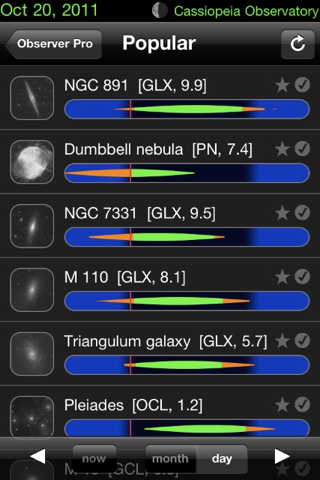
DSO Observing, Io Transit
Posted: 21 October 2011
The observatory was opened Thursday, 20 October, at 1812 MST, 80°F, to clear skies. 1820 MST: viewed Venus at 77X through tree branches. Switched to the 2" 30mm (67X) eyepiece. I then checked Observer Pro on my iPhone 4 to see what objects were currently visible. Here's the first screen of objects:

I would use that as a guide to observing this night. 1833 MST: observed M13 (globular cluster); it was visible even though the sky was still bright from evening twilight. While waiting for the sky to darken, I studied the Observer Pro list. At 1900 MST, I began observing using the list of objects from Observer Pro. I observed: NGC891 (galaxy), M27 (Dumbbell Nebula), NGC7331 (galaxy), M31/M32/M110 (galaxies), M33 (galaxy), M15 (globular cluster), M74 (galaxy), M2 (globular cluster), M76 (Little Dumbbell Nebula), NGC457 (open cluster), M71 (globular cluster), NGC7252 (galaxy), NGC6905 (planetary nebula), NGC7662 (Blue Snowball, planetary nebula), NGC6543 (Cat's Eye, planetary nebula), and NGC6445 (planetary nebula). Two objects on my list were currently behind the hill to the east. 1930 MST: finished the list for now.
Went to Jupiter, low in the east. Three moons were visible, one very close to the north polar region. I checked Pocket Universe on the iPhone and it showed that the moon was Ganymede and that it would begin a transit (I thought). Although Jupiter was too low for good observing, I tried anyway to see if I could watch the transit. I switched to the 1.25" 15mm eyepiece, then 9.7mm eyepiece with a moon filter. Having all my eyepieces at hand on my homemade eyepiece tray makes switching easy. Using the moon filter really improved the seeing; the disk of Ganymede was very obvious at 206X. As I watched Ganymede I quickly realized that its movement was in the wrong direction for there to be an upcoming transit. Ganymede had been in occultation with the planet. I confirmed this with the "Jupiter's Moons" tool on the Sky and Telescope web site. The tool also reported that Io and its shadow were currenly transiting the planet. With great difficulty (due to the poor seeing from Jupiter's low altitude) I finally managed to see Io's shadow at 1948 MST. The shadow was on the South Equatorial Belt (SEB), which helped improve its visibility. Now that I knew where to look, I began searching for Io. At 2001 MST, I saw Io; it was trailing its shadow and also on the SEB. By 2014 MST, even though Jupiter was higher in the sky, seeing was getting worse and it was getting difficult to detect Io and its shadow. 2028 MST: I was forced to reduce the magnification and switched to the 15mm (133X) eyepiece with the moon filter. The shadow was barely visible as it approached "3rd contact". Io was occasionally visible on the SEB as a "star-like" object. 2035 MST: shadow "4th contact" (I think). 2041 MST: Io now easily seen due to limb darkening. 2048 MST: Io transit ended. Seeing was horrible.
2053 MST: I observed NGC253 (galaxy) and NGC1055 (galaxy) from my observing list. Decided to close up due to the lousy seeing and the fact that I was still tired from the previous night's 8 hour session at the telescope.
Closed the observatory at 2107 MST, 68°F.
On my previous report I mentioned seeing a bright polar orbiting satellite. Thanks to Clay Davis (@claymdavis) and David Dickinson (@Astroguyz) on Twitter. David identified it as the PSLV Booster Debris. It matches time, trajectory, and speed. Thanks guys!
Go to the previous report.
Return to the Cassiopeia Observatory Welcome Page.